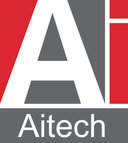Company Insight
Sponsored by Aitech
Artificial Intelligence Accelerates Rugged Autonomous Military Applications
Dan Mor, Director, GPGPU and Video Product Line of Aitech
Digital technologies applied to military electronics are fueling the rapid transformation of integrated communication systems, forming what is being called the Digital Backbone. By applying common foundational technologies across platforms, military systems can provide more effective, secure and efficient networks and help establish a more strategic competitive advantage. Artificial intelligence (AI) has joined the ranks of the advanced digital capabilities being integrated into rugged systems throughout military and defense applications, helping to facilitate high performance embedded computing (HPEC) in harsh environments.
The benefits of HPEC moving into AI-based independent or partially independent embedded supercomputers are primarily two-fold. HPEC systems enable far more functionality to be housed in a smaller framework, so that processing large datasets happens closer to the sensor, where it is needed most.
The intuitive processing that AI provides has propelled many modern military systems into this new area of high intensity computing using real time data, enabling autonomous decision making. AI in military systems is fueled by GPU (graphics processing unit) accelerated computing, which uses parallel processing versus serial, to enable the handling of thousands of data points simultaneously.
Ruggedization of these HPEC systems means that computing power can be used in a wider number of remote and mobile locations. As processing demands increase, SFF (small form factor) systems using GPGPU (general purpose graphics processing unit) technology and AI-based solutions are providing a path to next generation embedded systems, poised to tackle the growing field of mobile, unmanned and autonomous vehicle technologies.
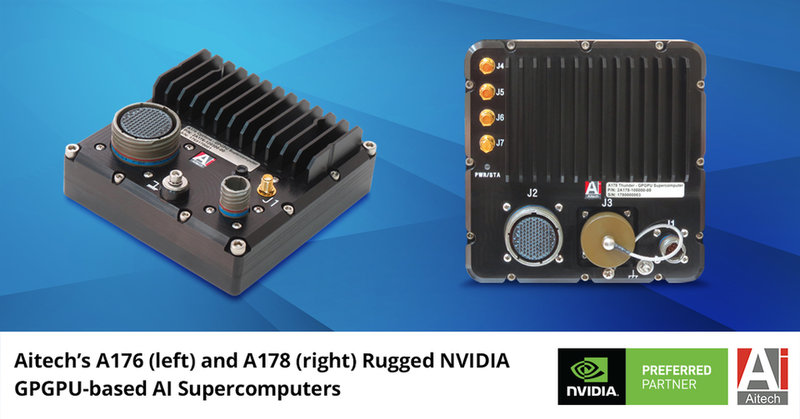
//FIGURE 1. The A176 & A178 AI Supercomputers from Aitech enable advanced data processing in a compact footprint.
Meeting Military Application Challenges
Today’s military systems are built with far more functionality in a much smaller footprint, typically referred to as optimized SWaP—size, weight and power—while still needing to keep costs low. In addition, these systems function in extremely harsh environments, and carry with them the need to operate reliably all the time, every time.
In addition to supporting crucial, lifesaving and security-focused applications, military systems need to withstand extreme shock and vibration as well as severe and expansive temperature and humidity fluctuations, ranging from sub-zero to triple digits. And these rugged, SWaP-optimized HPEC systems need to capture and process real-time data and graphics from several inputs simultaneously and manage it all from many I/O interfaces, providing what is known as “AI at the Edge.”
Meet today's tough data security compliance and exceed even the toughest government regulatory standards with kanguru.
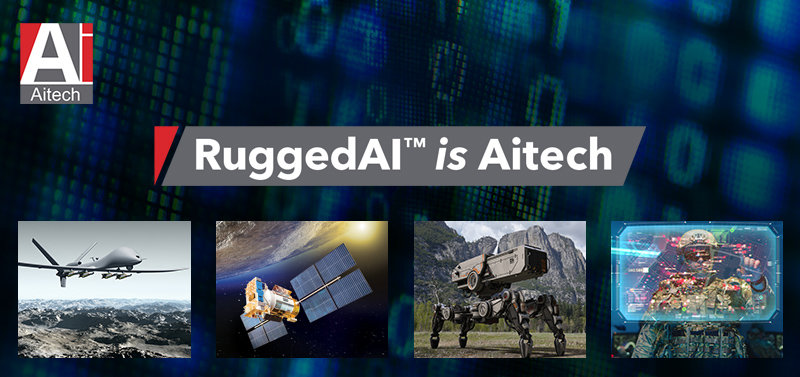
//FIGURE 2. Military applications are increasingly using rugged, SWaP-optimized HPEC systems based on leading-edge technologies, like GPGPU, that facilitate AI computing.
Balancing all these requirements pose their own challenges, but with the right ruggedization and system development techniques, embedded designers are developing AI-based supercomputers used throughout a number of military applications, such as situation awareness systems, EW systems and drones as well as smart soldier and man-portable systems and augmented reality. Especially noteworthy is the growing set of UAVs (unmanned aerial vehicles) utilizing this technology.
With some AI-based SWaP-optimized supercomputers offering an ultra-compact footprint, roughly the size of a cell phone, unmanned systems can achieve incredibly high performance with remarkable levels of energy efficiency. They can operate longer during a mission, offer better reliability and provide real-time data inputs by processing and transmitting that data back the main command center or even build upon existing vehicle platforms to extend the function of a single vehicle, effectively extending the amount of airspace one craft can cover.
Applying Rugged GPGPU in Military Systems
Proper system ruggedization makes it possible to utilize AI-based technology, as noted in these examples of both manned and unmanned mission-critical applications.
Air: Autonomous Electric Vertical Takeoff and Landing (eVTOL) Aircraft
Prototypes of pilotless eVTOLS are being rapidly developed, with many utilizing platforms that already exist, such as drones or unmanned helicopters, then integrating leading edge technologies to achieve the needed functionality of these air transport vehicles. The need for advanced features and increased computing functionality is being met by AI supercomputing. At the forefront of this technology revolution is rugged GPU accelerated computing, facilitated by The Digital Backbone infrastructure.

//FIGURE 3. eVTOLs are utilizing advanced processing as delivered by AI supercomputers, like Aitech’s A178 that uses the NVIDIA® Jetson™ AGX Xavier System-On-Module.
Space: Low-Earth Orbit Flight Test of an Inflatable Decelerator (NASA LOFTID)
As the birthplace of many a disruptive technology, space is also adopting advanced GPU accelerated computing technologies. A recent application includes an inflatable heat shield that acts as a giant brake by deploying a large inflatable aero shell (a deployable structure protected by a flexible heatshield) before entering the atmosphere. It’s targeted to retrieve reusable engines or for the delivery of heavier cargo to the surface of Mars. The GPGPU system collects video data and telemeters it to ground- or satellite-relay stations for near real-time monitoring of the entire reentry from deployment to touchdown.
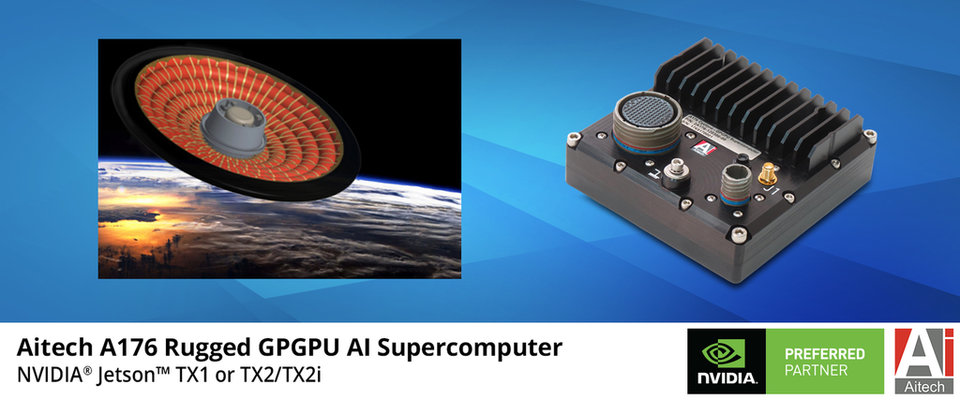
//FIGURE 4. Aitech’s A176 uses the NVIDIA® Jetson™ System-On-Module for video processing and data recording data on NASA’s LOFTID, a cross-cutting aeroshell for atmospheric re-entry.
Military Intelligence Continues to Evolve
How to design reliable systems for harsh environments is critical and includes even more specific technical considerations, such as which techniques will best mitigate the effects of things like environmental hazards as well as ensure that systems meet designated application requirements.
At Aitech, for example, the company’s entire line of GPGPU-based boards and small form factor (SFF) systems are qualified for, and survive in, several avionics, naval, ground and mobile applications, thanks to the decades of ruggedization expertise that is applied to system development. The company’s latest NVIDIA-based GPGPU innovations, the processing-intensive A179 and lower power A200, are classified as ultra-small form factors (USFFs) with a footprint roughly the size of a cell phone, yet offering teraflops of processing performance in a compact, ruggedized system.

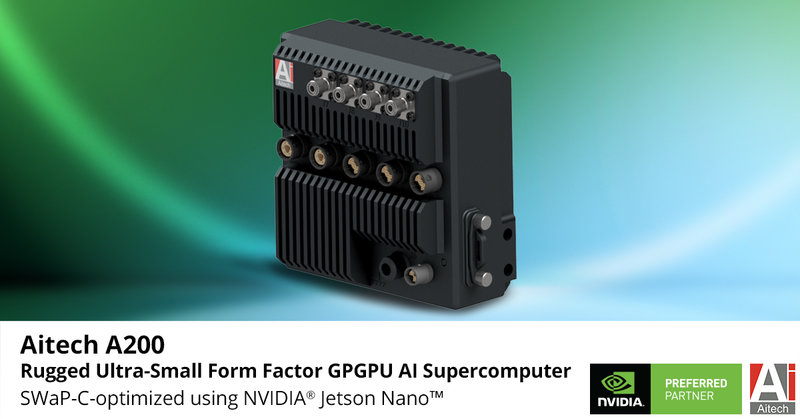
//FIGURE 5. Ultra-small form factor (USFF) systems, like the high performance A179 and lower power A200 AI supercomputers, offer a footprint roughly the size of a cell phone, yet provide teraflops of processing performance in a compact, ruggedized system.
For defense and military applications, AI has a unique opportunity to provide significant benefits across a range of activities. While industrial environments may garner financial and productivity benefits from implementing an AI-based strategy, mission-critical applications that protect human life and require extreme precision and accuracy are a different category altogether. Up-to-date, reliable operational intelligence is paramount to the success and safety of modern defense initiatives and enabling ruggedization across these systems is the key to mission success.
